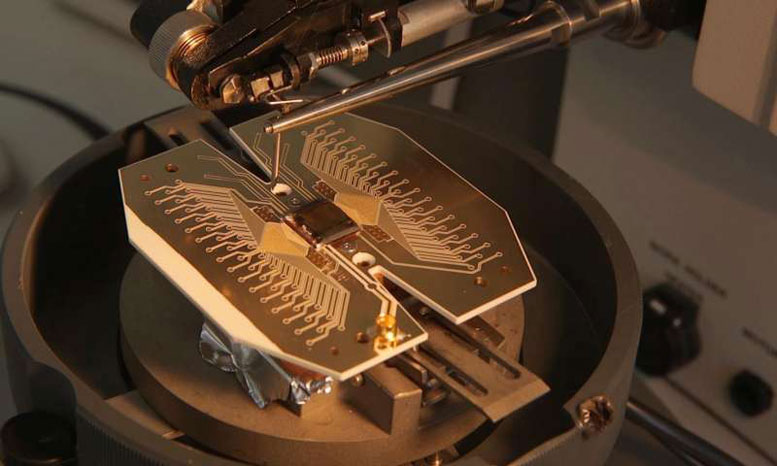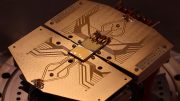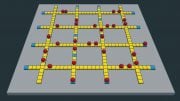
Prototype of the core of a trapped ion quantum computer. Credit: Ion Quantum Technology Group, University of Sussex
Scientists have unveiled the first ever practical blueprint for how to build a quantum computer.
This huge leap forward towards creating a universal quantum computer is published in the influential journal Science Advances.
It has long been known that such a computer would revolutionize industry, science, and commerce on a similar scale as the invention of ordinary computers. But this new work features the actual industrial blueprint to construct such a large-scale machine, more powerful in solving certain problems than any computer ever constructed before.
Once built, the computer’s capabilities mean it would have the potential to answer many questions in science; create new, lifesaving medicines; solve the most mind-boggling scientific problems; unravel the yet unknown mysteries of the furthest reaches of deepest space; and solve some problems that an ordinary computer would take billions of years to compute.
The work features a new invention permitting actual quantum bits to be transmitted between individual quantum computing modules in order to obtain a fully modular large-scale machine capable of reaching nearly arbitrary large computational processing powers.
Previously, scientists had proposed using fiber optic connections to connect individual computer modules. The new invention introduces connections created by electric fields that allow charged atoms (ions) to be transported from one module to another. This new approach allows 100,000 times faster connection speeds between individual quantum computing modules compared to current state-of-the-art fiber link technology.
The new blueprint is the work of an international team of scientists from the University of Sussex (UK), Google (USA), Aarhus University (Denmark), RIKEN (Japan), and Siegen University (Germany).
Professor Winfried Hensinger, head of the Ion Quantum Technology Group at the University of Sussex, who has been leading this research, said: “For many years, people said that it was completely impossible to construct an actual quantum computer. With our work we have not only shown that it can be done but now we are delivering a nuts and bolts construction plan to build an actual large-scale machine.”
Lead author Dr. Bjoern Lekitsch, also from the University of Sussex, explains: “It was most important to us to highlight the substantial technical challenges as well as to provide practical engineering solutions.”
As a next step, the team will construct a prototype quantum computer, based on this design, at the University.
The effort is part of the UK Government’s plan to develop quantum technologies towards industrial exploitation and makes use of a recent invention by the Sussex team to replace billions of laser beams required for quantum computing operations within a large-scale quantum computer with the simple application of voltages to a microchip.
Professor Hensinger said: “The availability of a universal quantum computer may have a fundamental impact on society as a whole. Without doubt it is still challenging to build a large-scale machine, but now is the time to translate academic excellence into actual application building on the UK’s strengths in this ground-breaking technology. I am very excited to work with industry and government to make this happen.”
The computer’s possibilities for solving, explaining, or developing could be endless. However, its size will be anything but small. The machine is expected to fill a large building, consisting of sophisticated vacuum apparatus featuring integrated quantum computing silicon microchips that hold individual charged atoms (ions) using electric fields.
The blueprint to develop such computers has been made public to ensure scientists throughout the world can collaborate and further develop this brilliant, ground-breaking technology as well as to encourage industrial exploitation.
The work is funded as part of UK’s National Quantum Technology Programme, a £270M investment by the UK Government to accelerate the translation of quantum technologies into the marketplace. The group is part of the UK Quantum Technology Hub on Networked Quantum Information Technologies which is funded by the Engineering and Physical Sciences Research Council (EPSRC). As the main funding agency for engineering and physical sciences research, its vision is for the UK to be the best place in the world to Research, Discover and Innovate.
Reference: “Blueprint for a microwave trapped ion quantum computer” by Bjoern Lekitsch, Sebastian Weidt, Austin G. Fowler, Klaus Mølmer, Simon J. Devitt, Christof Wunderlich and Winfried K. Hensinger, 1 February 2017, Science Advances.
DOI: 10.1126/sciadv.1601540









Be the first to comment on "Scientists Reveal Blueprint for How to Construct a Large Scale Quantum Computer"